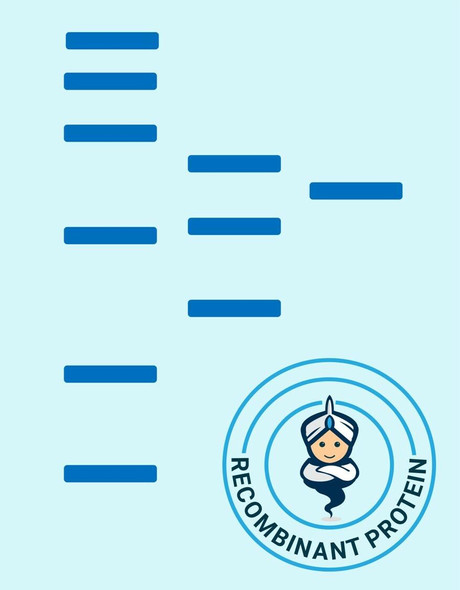Human FGF23 Recombinant Protein (RPPB0252)
- SKU:
- RPPB0252
- Product type:
- Recombinant Protein
- Size:
- 10ug
- Species:
- Human
- Target:
- FGF23
- Synonyms:
- Fibroblast growth factor 23
- FGF-23
- Phosphatonin
- Tumor-derived hypophosphatemia-inducing factor
- Source:
- Sf9 Insect cells
- Uniprot:
- Q9GZV9
Description
| Product Name: | Human FGF23 Recombinant Protein |
| Product Code: | RPPB0252 |
| Size: | 10µg |
| Species: | Human |
| Target: | FGF23 |
| Synonyms: | Fibroblast growth factor 23, FGF-23, Phosphatonin, Tumor-derived hypophosphatemia-inducing factor, HYPF. |
| Source: | Sf9 Insect cells |
| Physical Appearance: | Sterile filtered colorless solution. |
| Formulation: | FGF23 protein solution (0.25mg/ml) containsPhosphate Buffered Saline (pH 7.4), 2mM DTT, 1mM EDTA and 10% glycerol. |
| Stability: | Store at 4°C if entire vial will be used within 2-4 weeks. Store, frozen at -20°C for longer periods of time. For long term storage it is recommended to add a carrier protein (0.1% HSA or BSA).Avoid multiple freeze-thaw cycles. |
| Purity: | Greater than 90.0% as determined by SDS-PAGE. |
| Amino Acid Sequence: | ADPYPNASPL LGSSWGGLIH LYTATARNSY HLQIHKNGHV DGAPHQTIYS ALMIRSEDAGFVVITGVMSR RYLCMDFRGN IFGSHYFDPE NCRFQHQTLE NGYDVYHSPQ YHFLVSLGRAKRAFLPGMNP PPYSQFLSRR NEIPLIHFNT PIPRRHTRSA EDDSERDPLN VLKPRARMTPAPASCSQELP SAEDNSPMAS DPLGVVRGGR VNTHAGGTGP EGCRPFAKFI HHHHHH |
FGF-23 is a member of the fibroblast growth factor (FGF) family. FGF family members possess broad mitogenic and cell survival activities and are involved in a variety of biological processes including embryonic development, cell growth, tissue repair, morphogenesis, tumor growth and invasion. FGF-23 inhibits renal tubular phosphate transport. This gene was identified by its mutations associated with autosomal dominant hypophosphatemic rickets (ADHR), an inherited phosphate wasting disorder. a high level expression of FGF23 was found in oncogenic hypophosphatemic osteomalacia (OHO), a phenotypically similar disease caused by abnormal phosphate metabolism.
FGF23 produced in Sf9 Insect cells is a single, glycosylated polypeptide chain containing 236 amino acids (25-251a.a.) and having a molecular mass of 26.4kDa (Molecular size on SDS-PAGE will appear at approximately 13.5-18kDa).FGF23 is expressed with an 9 amino acid His tag at C-Terminus and purified by proprietary chromatographic techniques.
| UniProt Protein Function: | FGF23: Regulator of phosphate homeostasis. Inhibits renal tubular phosphate transport by reducing SLC34A1 levels. Upregulates EGR1 expression in the presence of KL. Acts directly on the parathyroid to decrease PTH secretion. Regulator of vitamin-D metabolism. Negatively regulates osteoblast differentiation and matrix mineralization. Defects in FGF23 are the cause of autosomal dominant hypophosphataemic rickets (ADHR). ADHR is characterized by low serum phosphorus concentrations, rickets, osteomalacia, leg deformities, short stature, bone pain and dental abscesses. Defects in FGF23 are a cause of hyperphosphatemic familial tumoral calcinosis (HFTC). HFTC is a severe autosomal recessive metabolic disorder that manifests with hyperphosphatemia and massive calcium deposits in the skin and subcutaneous tissues. Belongs to the heparin-binding growth factors family. |
| UniProt Protein Details: | Protein type:Secreted, signal peptide; Secreted; Cytokine Chromosomal Location of Human Ortholog: 12p13.3 Cellular Component: extracellular space; extracellular region Molecular Function:growth factor activity; type 1 fibroblast growth factor receptor binding Biological Process: epidermal growth factor receptor signaling pathway; negative regulation of bone mineralization; phosphoinositide-mediated signaling; fibroblast growth factor receptor signaling pathway; cellular phosphate ion homeostasis; nerve growth factor receptor signaling pathway; positive regulation of transcription, DNA-dependent; negative regulation of hormone secretion; insulin receptor signaling pathway; innate immune response; negative regulation of osteoblast differentiation; phosphate ion homeostasis; cell differentiation; phosphate metabolic process; vitamin D catabolic process Disease: Hypophosphatemic Rickets, Autosomal Dominant |
| NCBI Summary: | This gene encodes a member of the fibroblast growth factor family of proteins, which possess broad mitogenic and cell survival activities and are involved in a variety of biological processes. The product of this gene regulates phosphate homeostasis and transport in the kidney. The full-length, functional protein may be deactivated via cleavage into N-terminal and C-terminal chains. Mutation of this cleavage site causes autosomal dominant hypophosphatemic rickets (ADHR). Mutations in this gene are also associated with hyperphosphatemic familial tumoral calcinosis (HFTC). [provided by RefSeq, Feb 2013] |
| UniProt Code: | Q9GZV9 |
| NCBI GenInfo Identifier: | 13626688 |
| NCBI Gene ID: | 8074 |
| NCBI Accession: | Q9GZV9.1 |
| UniProt Secondary Accession: | Q9GZV9,Q4V758, |
| UniProt Related Accession: | Q9GZV9 |
| Molecular Weight: | |
| NCBI Full Name: | Fibroblast growth factor 23 |
| NCBI Synonym Full Names: | fibroblast growth factor 23 |
| NCBI Official Symbol: | FGF23 |
| NCBI Official Synonym Symbols: | ADHR; FGFN; HYPF; HPDR2; PHPTC |
| NCBI Protein Information: | fibroblast growth factor 23; phosphatonin; tumor-derived hypophosphatemia inducing factor |
| UniProt Protein Name: | Fibroblast growth factor 23 |
| UniProt Synonym Protein Names: | Phosphatonin; Tumor-derived hypophosphatemia-inducing factorCleaved into the following 2 chains:Fibroblast growth factor 23 N-terminal peptide; Fibroblast growth factor 23 C-terminal peptide |
| Protein Family: | Fibroblast growth factor |
| UniProt Gene Name: | FGF23 |
| UniProt Entry Name: | FGF23_HUMAN |










